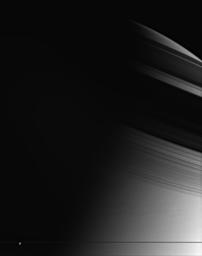
|
Pencil-thin Rings
- Click the image above for a larger view
- Full-Res JPEG (591 x 748) (13.5 kB)
- Full-Res TIFF (591 x 748) (442.8 kB)
Caption:
If all the material that makes up Saturn's rings were compressed into a single body, it could make a moon roughly 80 percent the size of Saturn's moon Enceladus (505 kilometers, or 314 miles across). Enceladus is seen here against the darkness of the planet's night side.
Saturn's rings are incredibly thin by astronomical standards; in most places no thicker than the height of a two-story building. Their apparent thickness here is deceptive, as Cassini is not located precisely within the ringplane, and the image resolution is greater than the physical thickness of the rings.
Long, threadlike shadows cast by the rings adorn the atmosphere in this somewhat eerie scene.
The image was taken in visible light with the Cassini spacecraft wide-angle camera on March 11, 2005, at a distance of approximately 1.3 million kilometers (800,000 miles) from Saturn. The image scale is 74 kilometers (46 miles) per pixel.
Background Info:
The Cassini-Huygens mission is a cooperative project of NASA, the European Space Agency and the Italian Space Agency. The Jet Propulsion Laboratory, a division of the California Institute of Technology in Pasadena, manages the mission for NASA's Science Mission Directorate, Washington, D.C. The Cassini orbiter and its two onboard cameras were designed, developed and assembled at JPL. The imaging team is based at the Space Science Institute, Boulder, Colo.
For more information about the Cassini-Huygens mission visit http://saturn.jpl.nasa.gov . For additional images visit the Cassini imaging team homepage http://ciclops.org .
Cataloging Keywords:
| Name | Value | Additional Values |
|---|---|---|
| Target | Enceladus | Saturn, Saturn Rings |
| System | Saturn | |
| Target Type | Satellite | Planet, Ring |
| Mission | Cassini-Huygens | |
| Instrument Host | Cassini Orbiter | |
| Host Type | Orbiter | |
| Instrument | Imaging Science Subsystem (ISS) | |
| Detector | Wide Angle Camera | |
| Extra Keywords | Atmosphere, Grayscale, Shadow, Visual | |
| Acquisition Date | ||
| Release Date | 2005-05-18 | |
| Date in Caption | 2005-03-11 | |
| Image Credit | NASA/JPL/Space Science Institute | |
| Source | photojournal.jpl.nasa.gov/catalog/PIA06651 | |
| Identifier | PIA06651 | |
